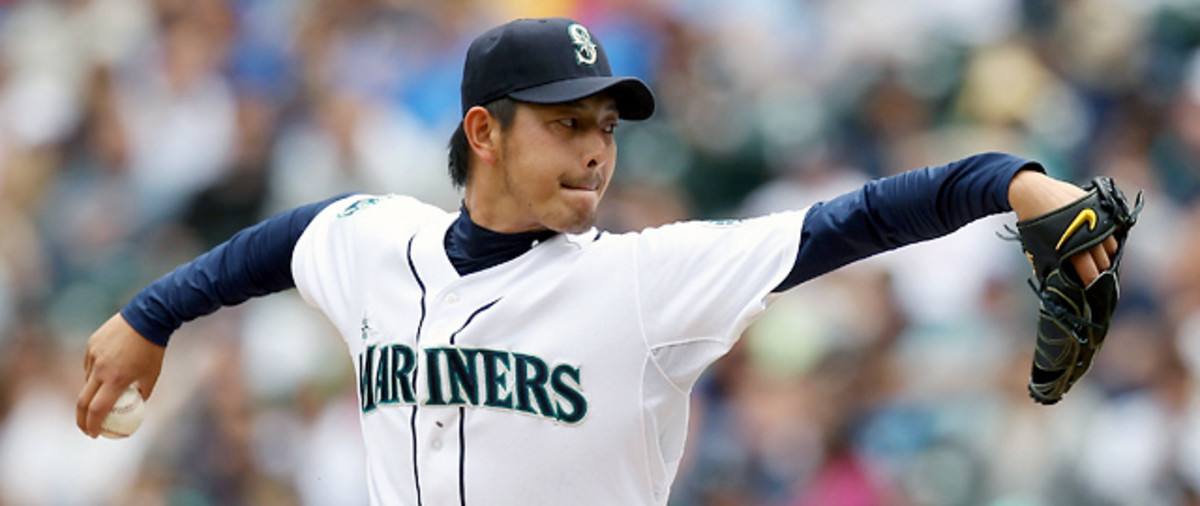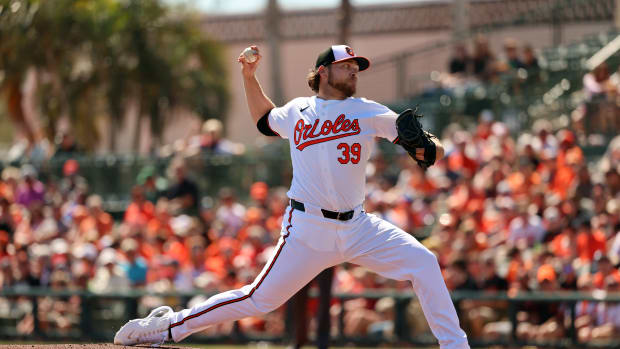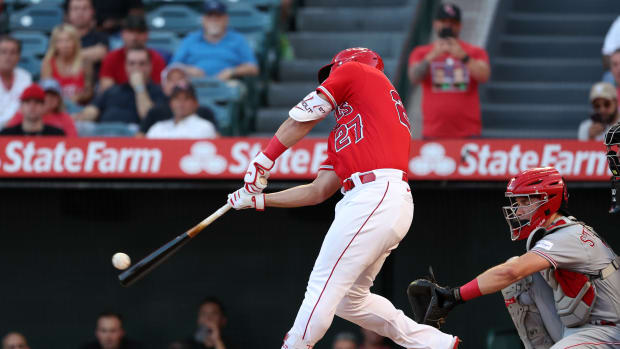Mariners' second-half surge fueled by run prevention
Not just Felix: Hisashi Iwakuma is 3-2 with a 2.37 ERA over his last seven starts. [Otto Greule Jr/Getty Images]
Amid the dismal news about Carl Crawford and Bartolo Colon, the Mariners have quietly provided one of the more positive stories of late. Felix Hernandez's perfect game got the headlines, and deservedly so, but fewer people have noticed that the Mariners have now reeled off eight straight wins, a stretch that has lifted them above the Red Sox in the AL wild-card standings. Coming into Thursday, their record stands at 61-64, with a run differential that's now in the black at +6.
Furthermore, since the All-Star break, Seattle has the league's best record at 25-13, a half-game better than the A's and a full game better than the Rays, the two teams currently leading the wild-card race. While the Mariners aren't much of a threat to pass the five teams above them -- they're 3 1/2 games behind the next-closest team, the Angels -- they have a very good chance to play the spoiler down the stretch. Ten of their remaining 12 series are against teams in the playoff hunt.
How have the Mariners turned their season around? Basically, by putting the clamps down on opponents:
Split | W-L | WPct | RS/Game | RA/Game |
First Half | 36-51 | .414 | 3.87 | 4.20 |
Second Half | 25-13 | .658 | 4.05 | 3.16 |
While their offense has improved slightly from the first half to the second half, the Mariners' run prevention has improved by more than a full run per game. Hernandez has been brilliant, pitching to a 1.41 ERA in eight starts (three shutouts), with a 51/10 strikeout-to-walk ratio in 64 innings. Two other starters have ERAs below 3.00 in that span, namely Jason Vargas (2.16) and Hisashi Iwakuma (2.77). Blake Beavan's 3.74 ERA is a vast improvement over his first half mark of 5.92, and is accompanied by a 27/3 strikeout-to-walk ratio, while Kevin Millwood's 5.44 mark is the only true dud; even that has more to do with the results on balls in play (.352 BABIP) than the stuff under his control (4.41 FIP).
In all, that's a 2.98 second-half ERA from the starting five, thanks in large part to low homer and walk rates (0.8 and 1.9 per nine, respectively) offsetting a subpar strikeout rate of 6.0 per nine. Meanwhile, the bullpen has yielded a 3.05 ERA in the second half while whiffing 9.3 per nine. Those second-half performances have pushed the team's overall run prevention rate to 3.88 per game, third in the league behind the Rays (3.66) and A's (3.76), helping to offset an offense that ranks dead last in the league at 3.93 runs per game.
Indeed, appreciating the Mariners' changing fortunes isn't so easily given the statistical fog created by the team's run-suppressing home, Safeco Field, or the hole that they dug for themselves earlier in the season. On the first subject, the Mariners and their opponents have combined to score just 3.11 runs per game in 63 games at Safeco this year, by far the lowest rate in the majors:
Park | Team | RPG (per team) |
Safeco Field | SEA | 3.11 |
AT&T Park | SFG | 3.34 |
Dodger Stadim | LAD | 3.52 |
Tropicana Field | TBR | 3.56 |
PNC Park | PIT | 3.59 |
PetCo Park | SDP | 3.63 |
Coliseum | OAK | 3.66 |
Nationals Park | WSN | 3.92 |
Citi Field | NYM | 4.06 |
Angel Stadium | LAA | 4.10 |
Wrigley Field | CHC | 4.14 |
Marlins Park | MIA | 4.18 |
MinuteMaidPark | HOU | 4.22 |
CitizensBank | PHI | 4.24 |
Great American Ballpark | CIN | 4.27 |
Progressive | CLE | 4.33 |
Turner Field | ATL | 4.33 |
Busch Stadium | STL | 4.35 |
Yankee Stadium | NYY | 4.42 |
Kauffman Stadium | KCR | 4.53 |
Comerica Park | DET | 4.65 |
Camden Yards | BAL | 4.73 |
Rogers Centre | TOR | 4.85 |
US Cellular Field | CHW | 4.94 |
Target Field | MIN | 5.02 |
Chase Field | ARI | 5.02 |
Miller Park | MIL | 5.05 |
Rangers Ballpark | TEX | 5.07 |
Fenway Park | BOS | 5.26 |
Coors Field | COL | 6.15 |
As microscopic as the scoring rate at Safeco is, it's not even the lowest of the last two years; that "honor" belongs to the Giants' AT&T Park last year, which hosted just 3.01 runs per team per game. The all-time record is 2.64 in Dodger Stadium in 1968, the "Year of the Pitcher," when offensive levels cratered to such an absurd level that several rule changes were instituted.
The Mariners themselves have scored just 3.19 runs per game at Safeco on .213/.287/.318 hitting, numbers which represent major-league lows in their respective categories. While their .249/.301/.405 road line doesn't look particularly impressive except by comparison, they're scoring 4.68 runs per game away from home, a mark that's tied for eighth in the majors with the Rangers, who by contrast crank out 5.52 runs per game at home.
As for that hole, the Mariners stumbled in the first half in part thanks to a .195/.273/.289 performance by their offense in at home, with five of the team's 11 most frequently-used hitters putting up sub-.200 batting averages and nine of them posting sub-.300 on-base percentages. While the unit's numbers at home are hardly sterling in the second half (.246/.312/.372), they represent substantial improvement.
Have the Mariners really turned a corner? Given so many remaining games against contenders, they're still not guaranteed to avoid their fourth sub-.500 finish in the last five years, and seventh in the last nine. While the benching of Chone Figgins and the trade of Ichiro Suzuki have proven to be addition by subtraction (they're 19-9 since moving the latter), few of their young hitters have produced as expected:
Player | Age | PA | AVG | OBP | SLG | TAv | WARP |
Jesus Montero | 22 | 427 | .259 | .302 | .398 | .257 | -0.2 |
Alex Liddi | 23 | 114 | .231 | .289 | .365 | .242 | -0.2 |
24 | 491 | .249 | .313 | .398 | .267 | 1.3 | |
Dustin Ackley | 24 | 518 | .229 | .300 | .331 | .249 | 0.8 |
Michael Saunders | 25 | 453 | .246 | .299 | .415 | .272 | 1.2 |
25 | 405 | .189 | .254 | .324 | .208 | -2.7 | |
Mike Carp | 26 | 164 | .206 | .311 | .355 | .246 | -0.1 |
Casper Wells | 27 | 246 | .227 | .290 | .382 | .249 | -0.3 |
John Jaso | 28 | 263 | .289 | .408 | .493 | .350 | 2.9 |
Brendan Ryan | 30 | 370 | .200 | .291 | .286 | .236 | 1.0 |
Munenori Kawasaki | 31 | 104 | .202 | .265 | .213 | .192 | -0.6 |
Miguel Olivo | 33 | 247 | .219 | .232 | .372 | .231 | 0.5 |
Chone Figgins | 34 | 181 | .186 | .259 | .282 | .209 | -0.9 |
38 | 423 | .261 | .288 | .353 | .235 | 0.4 |
TAv is True Average, a Baseball Prospectus stat expressing runs produced per out on a batting average scale after adjusting for park and league scoring levels, with .260 considered average. So even after adjusting for the difficult offensive environment, only third baseman Kyle Seager, center fielder Michael Saunders, and designated hitter/catcher John Jaso rate as above-average hitters. That's especially dismaying given that Montero, Smoak and Ackley were once considered blue-chip prospects, with eight appearances in the top 25 of Baseball America's Top 100 Prospect lists between them: four for Montero (three in the top 10, including number three in 2011), two apiece for Ackley (maxing out at 11th in 2010) and Smoak (topping out at 13th in 2010). All represent considerable investments; Ackley was the overall No. 2 pick of the 2009 draft, while Smoak arrived in the 2010 trade that sent Cliff Lee to Texas, and Montero in the January trade that sent Michael Pineda to the Yankees. Seager, a third-round 2009 pick, and Saunders, who ranked 30th on BA's list in 2010, have offset those disappointing showings at least somewhat, as has late-July acquisition Eric Thames, who has hit .286/.318/.540 in 66 plate appearances while taking over right field from Suzuki. All three need to improve their plate discipline in order to be truly productive players, but they're closer to holding up their end of the bargain than Ackley, Montero, and Smoak.
Likewise, beyond Hernandez (2.54 ERA) and Vargas (3.53), the rotation hasn't covered itself in glory. Millwood's 4.29 ERA is 12 percent worse than the park-adjusted league average, while Beavan's 5.00 mark and the 5.77 put up by Hector Noesi (who was also acquired in the Pineda trade) are rather grim. Iwakuma, a 31-year-old Japanese import in his first stateside season, has fared reasonably well in a swingman role, but he still has just four quality starts out of nine. Help for the unit could be available as early as next year in the form of 2010 supplemental first-round pick Tajuan Walker and 2011 overall number two pick Danny Hultzen, who came into the year 20th and 21st on the BA list; the former is in Double-A, the latter in Triple-A. James Paxton, a 2010 fourth-round pick who was 52nd on BA's list, is also at Double-A.




































